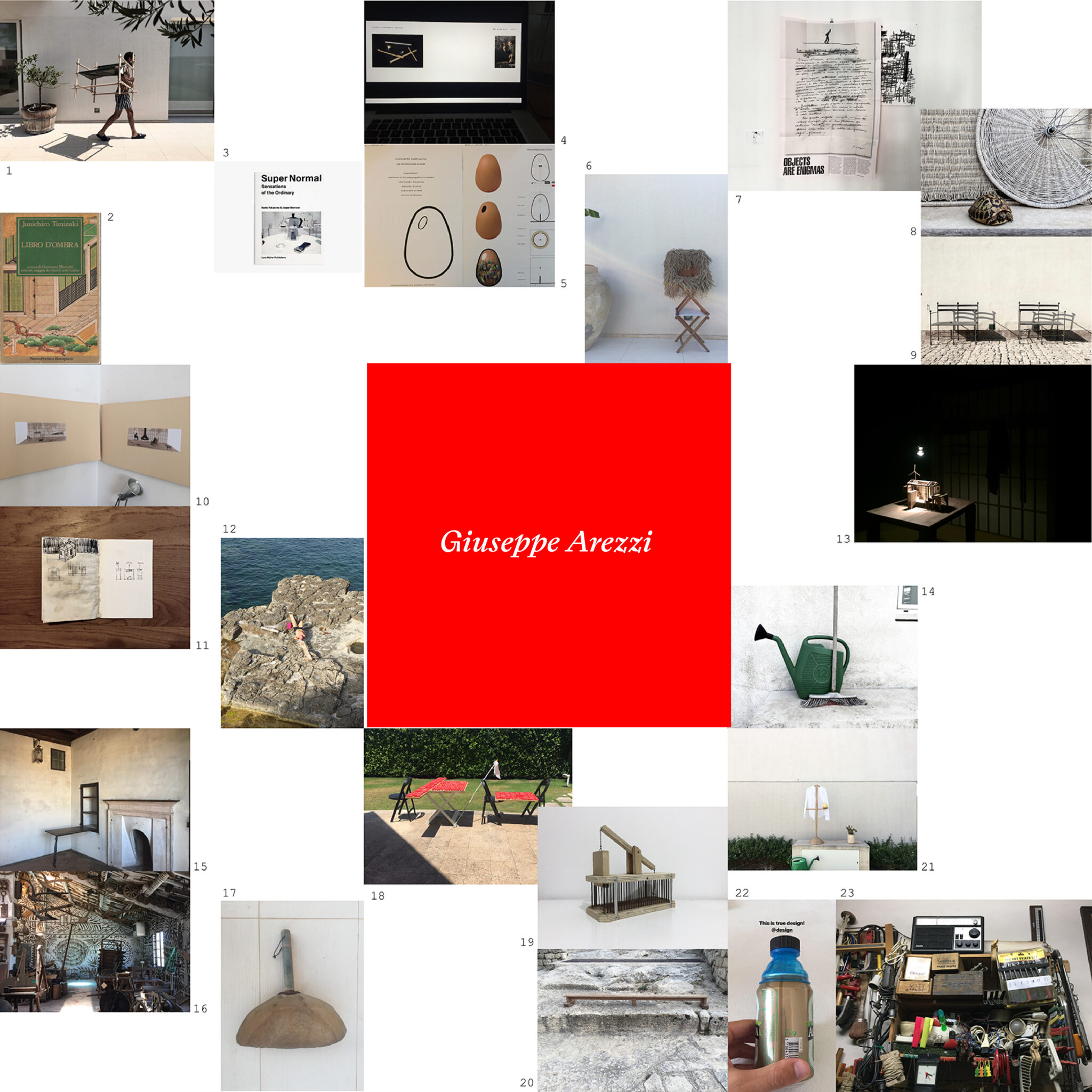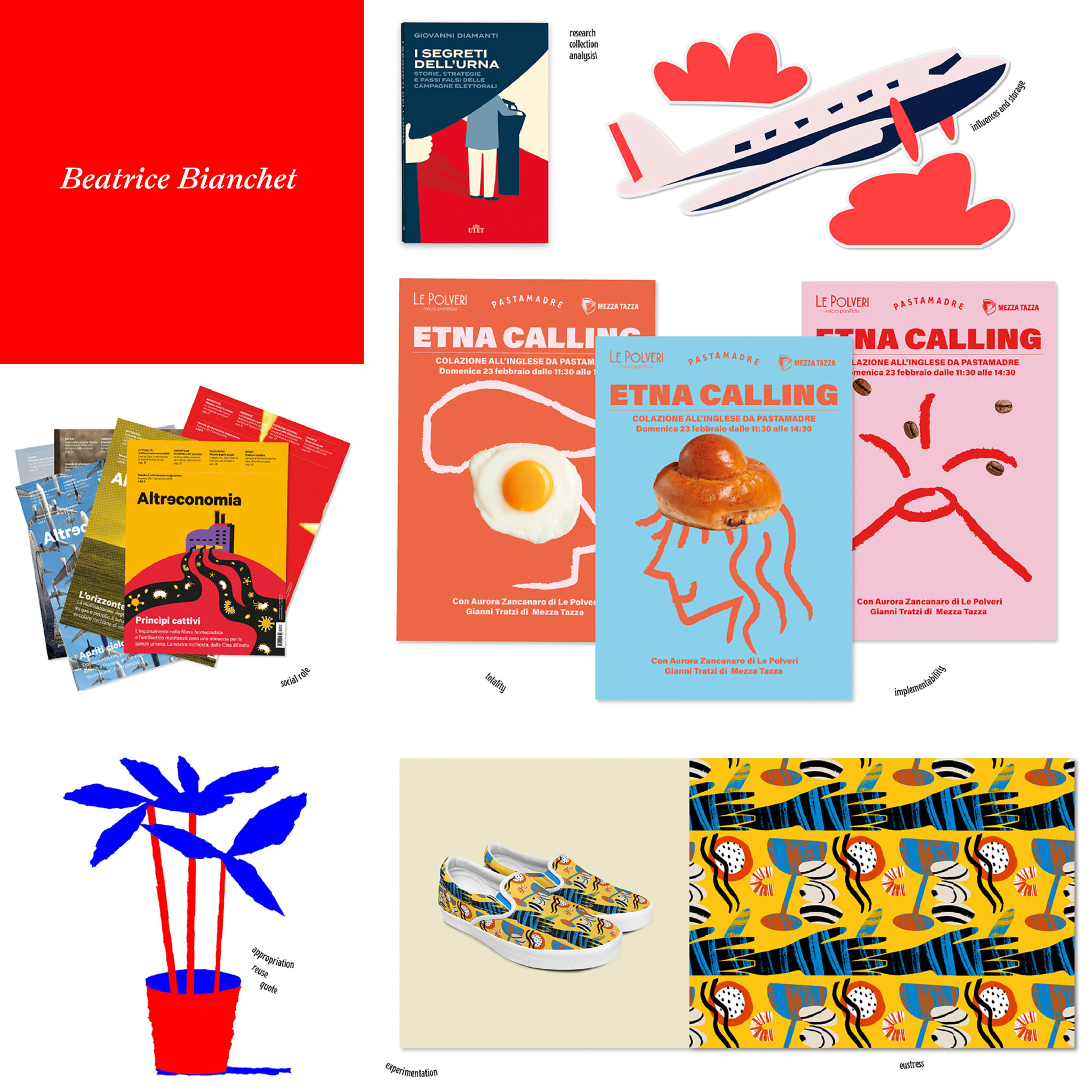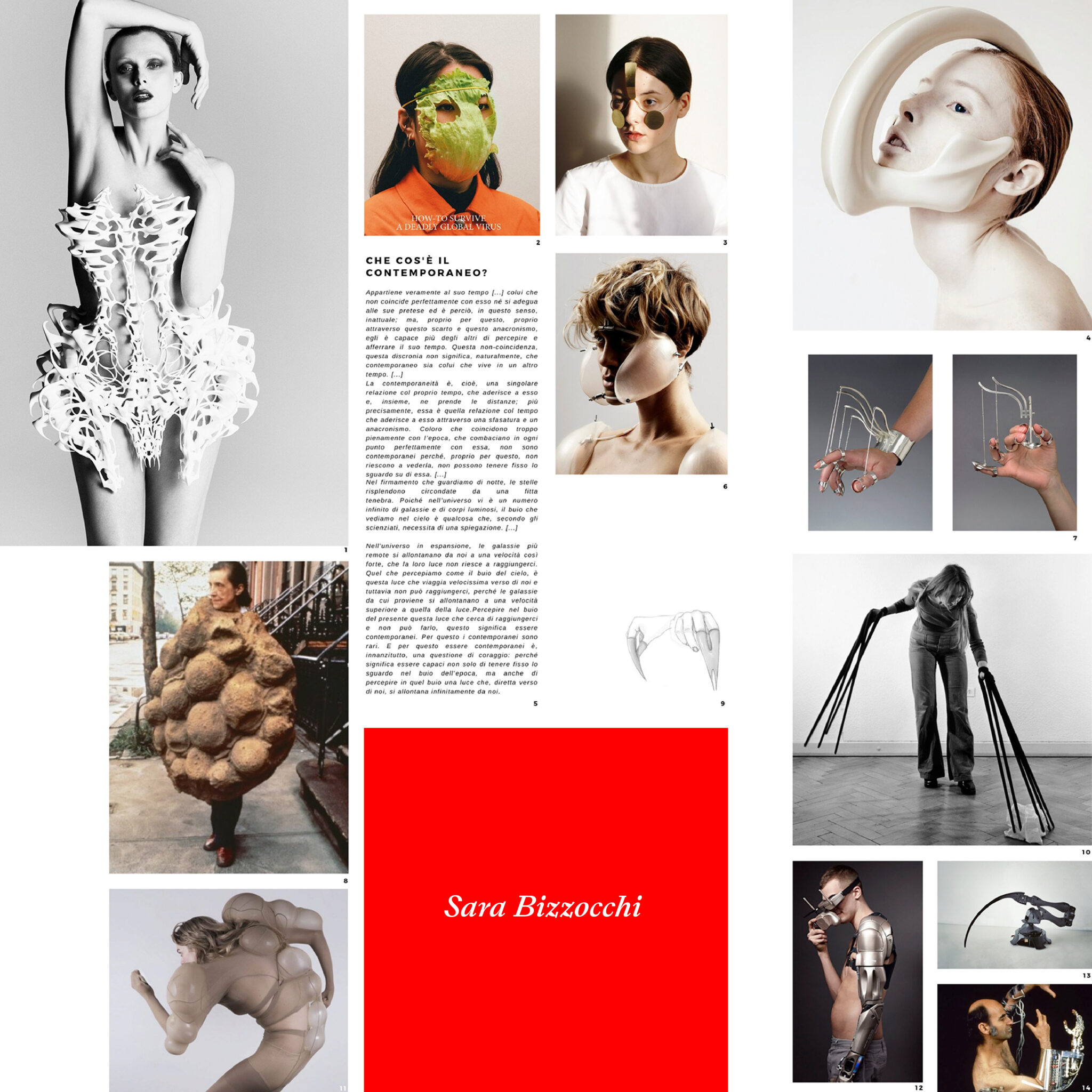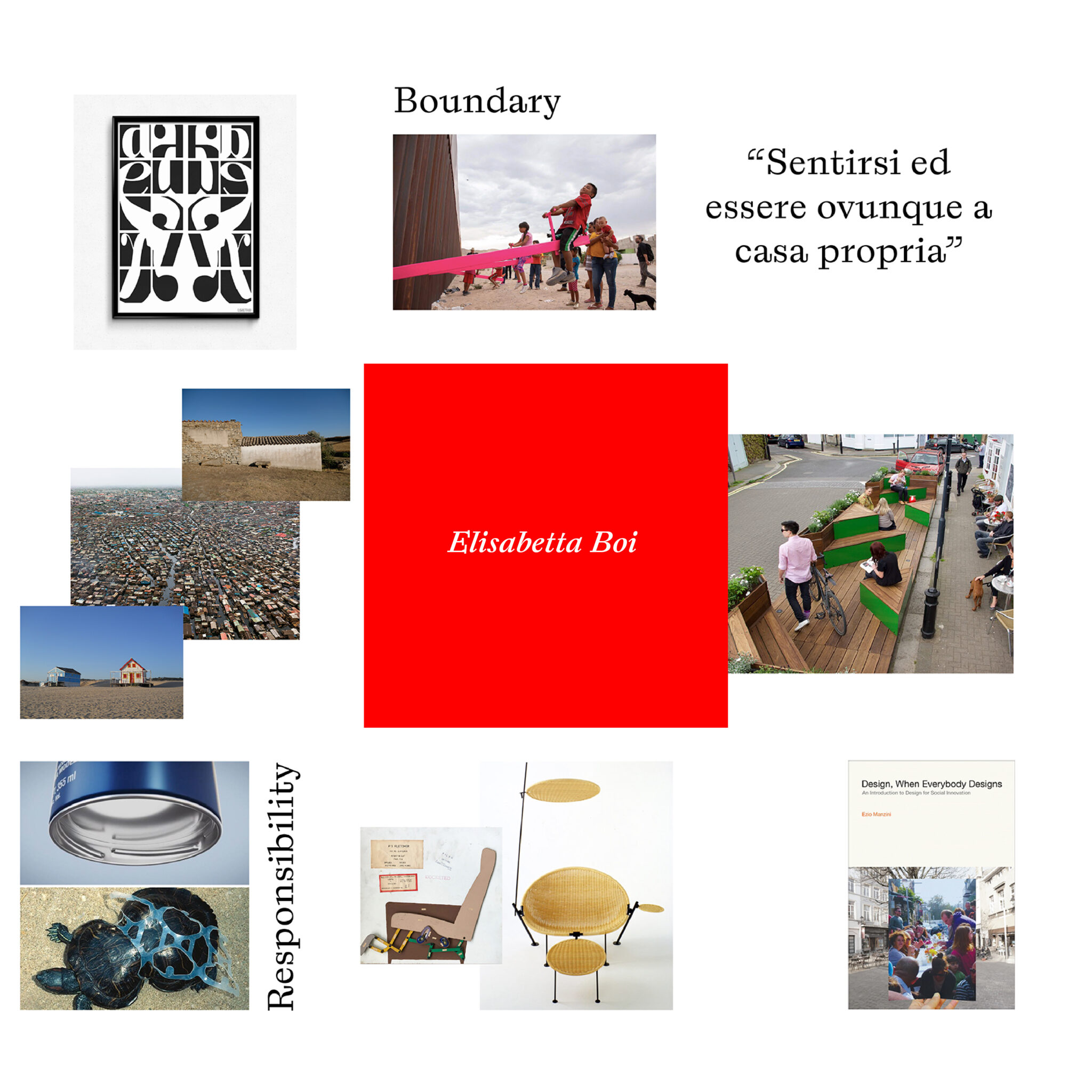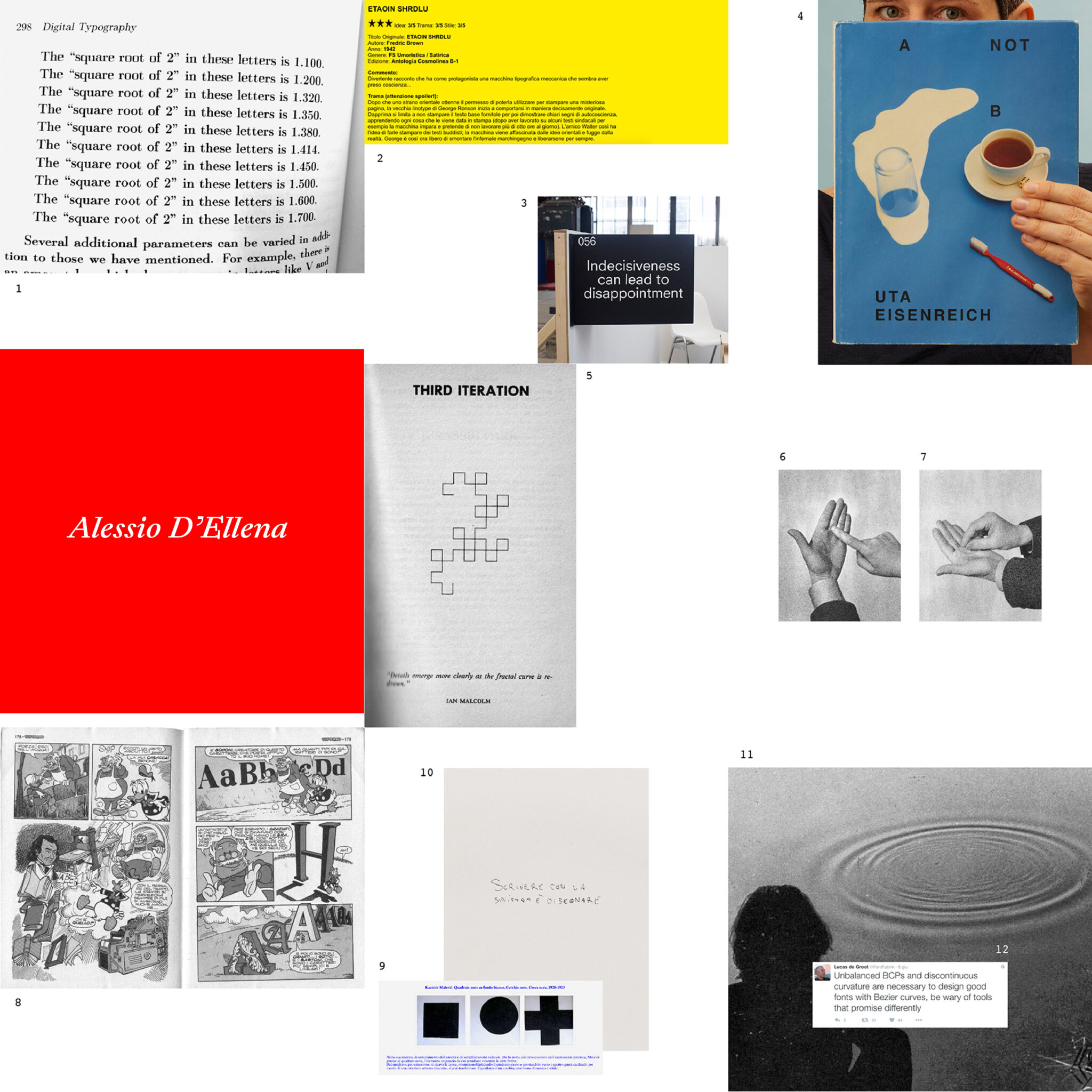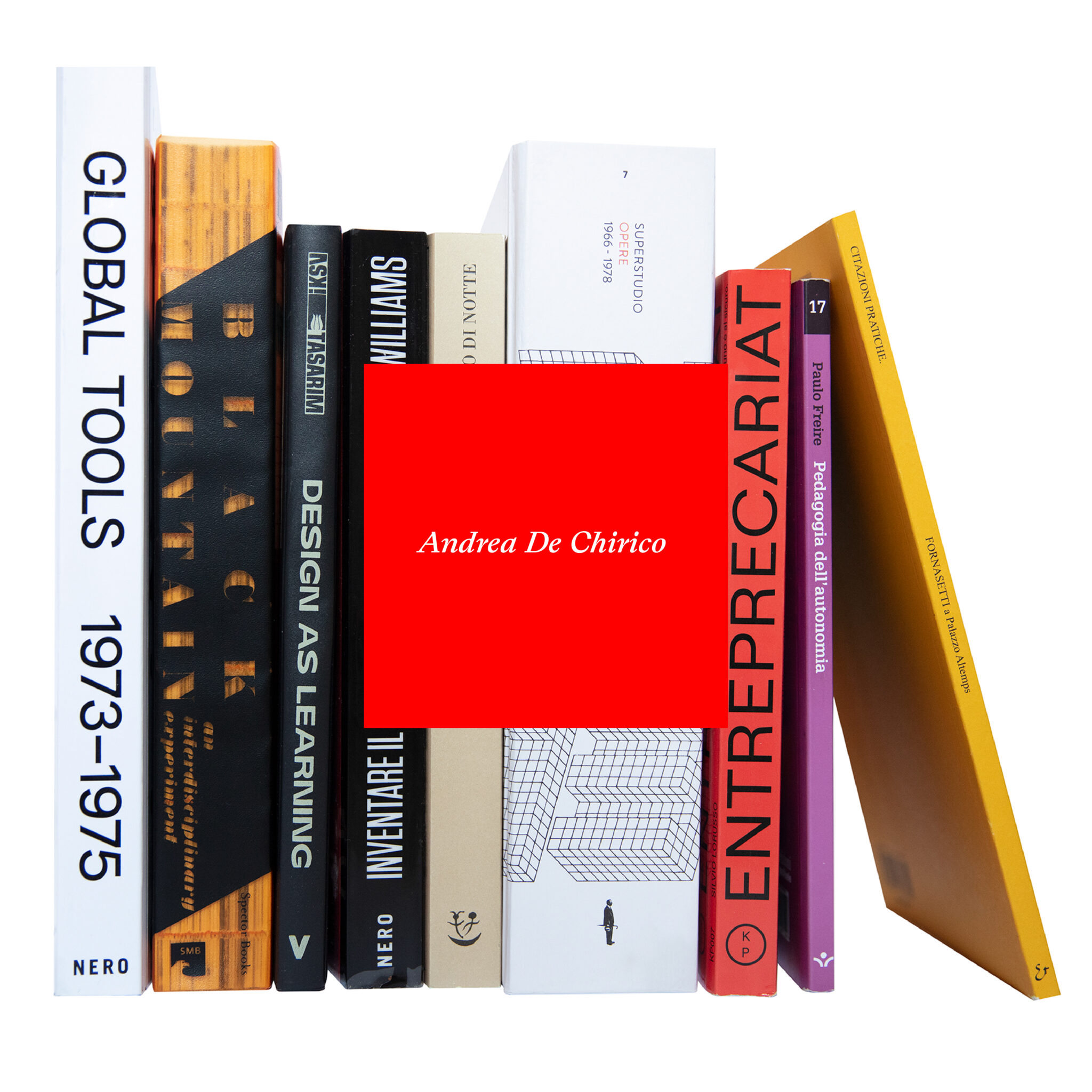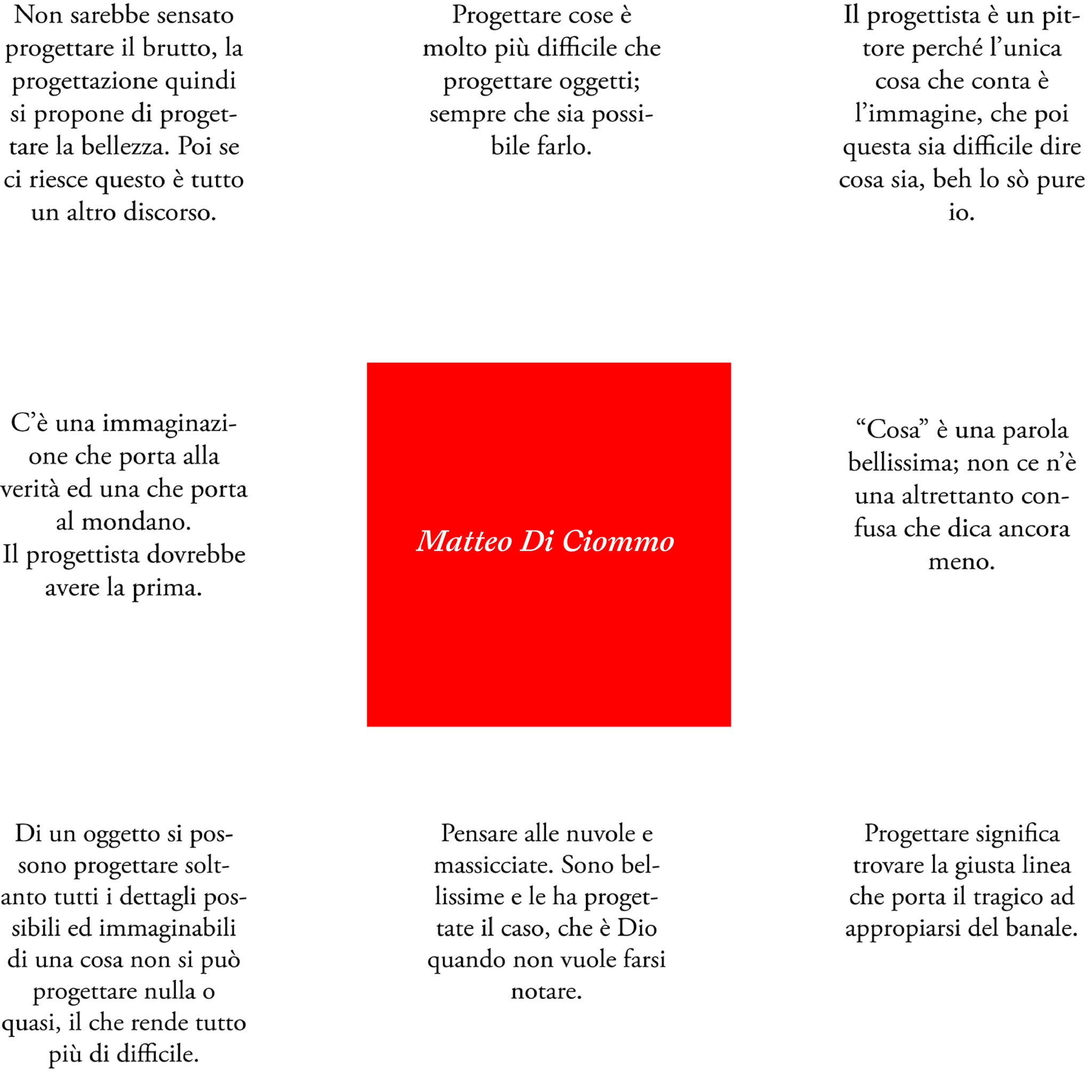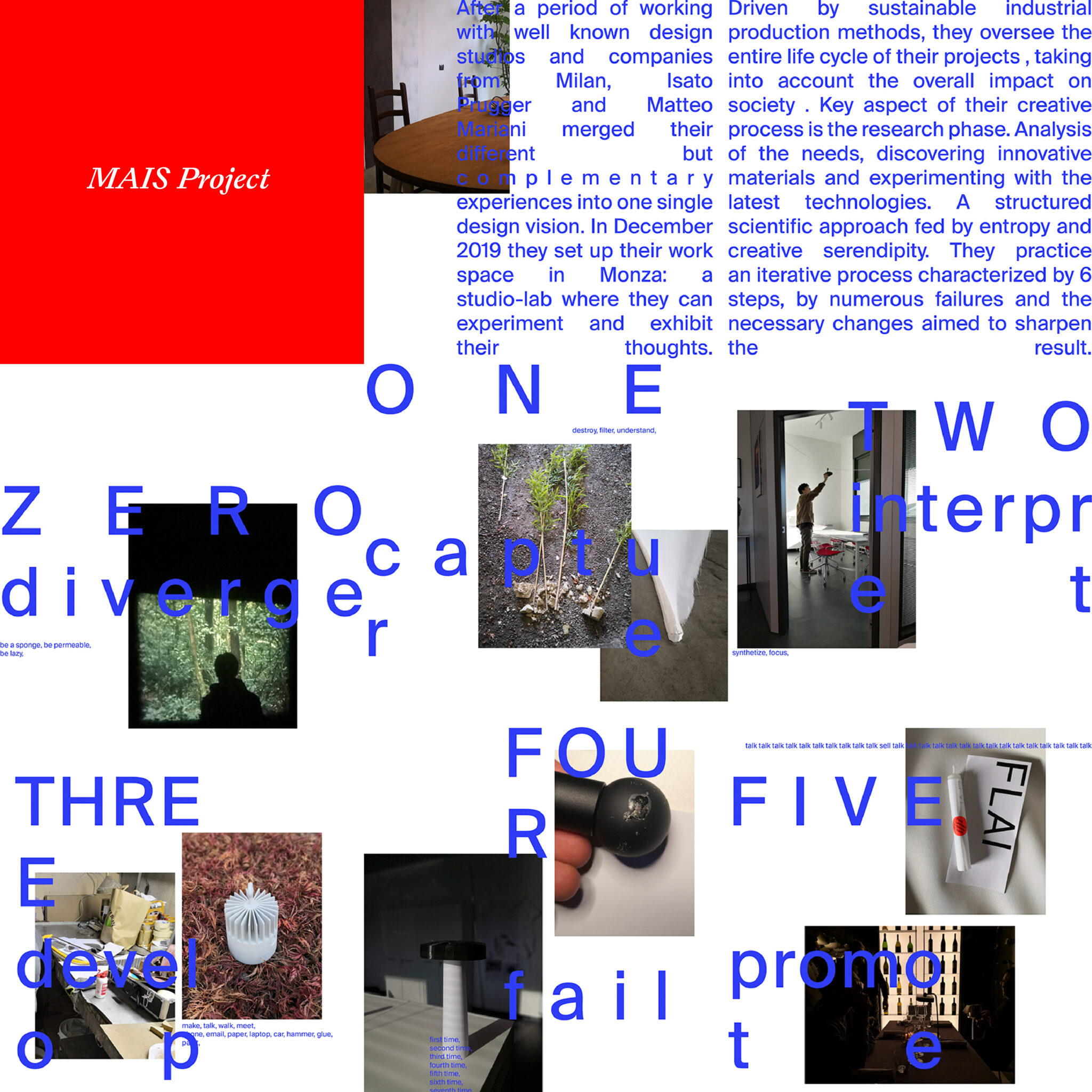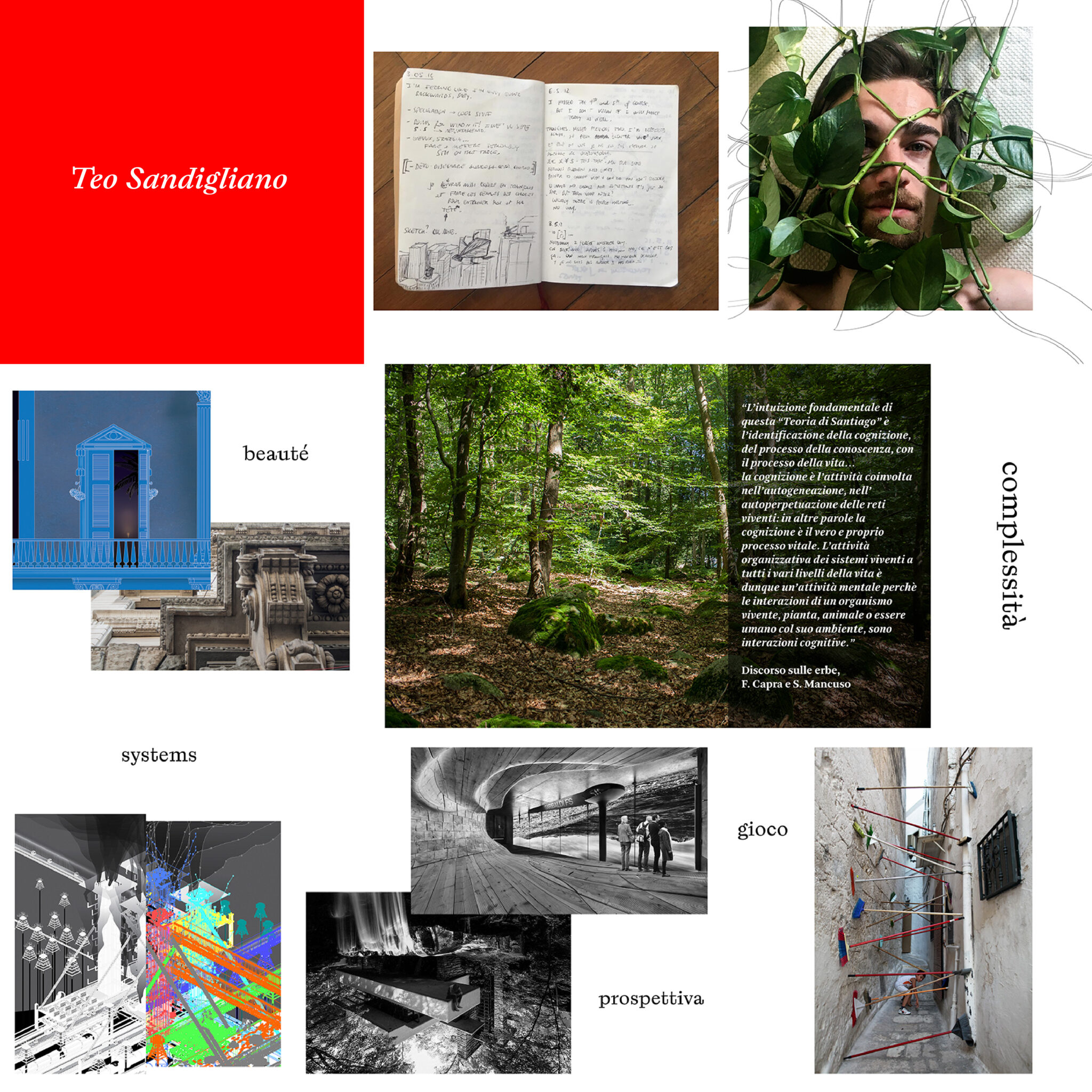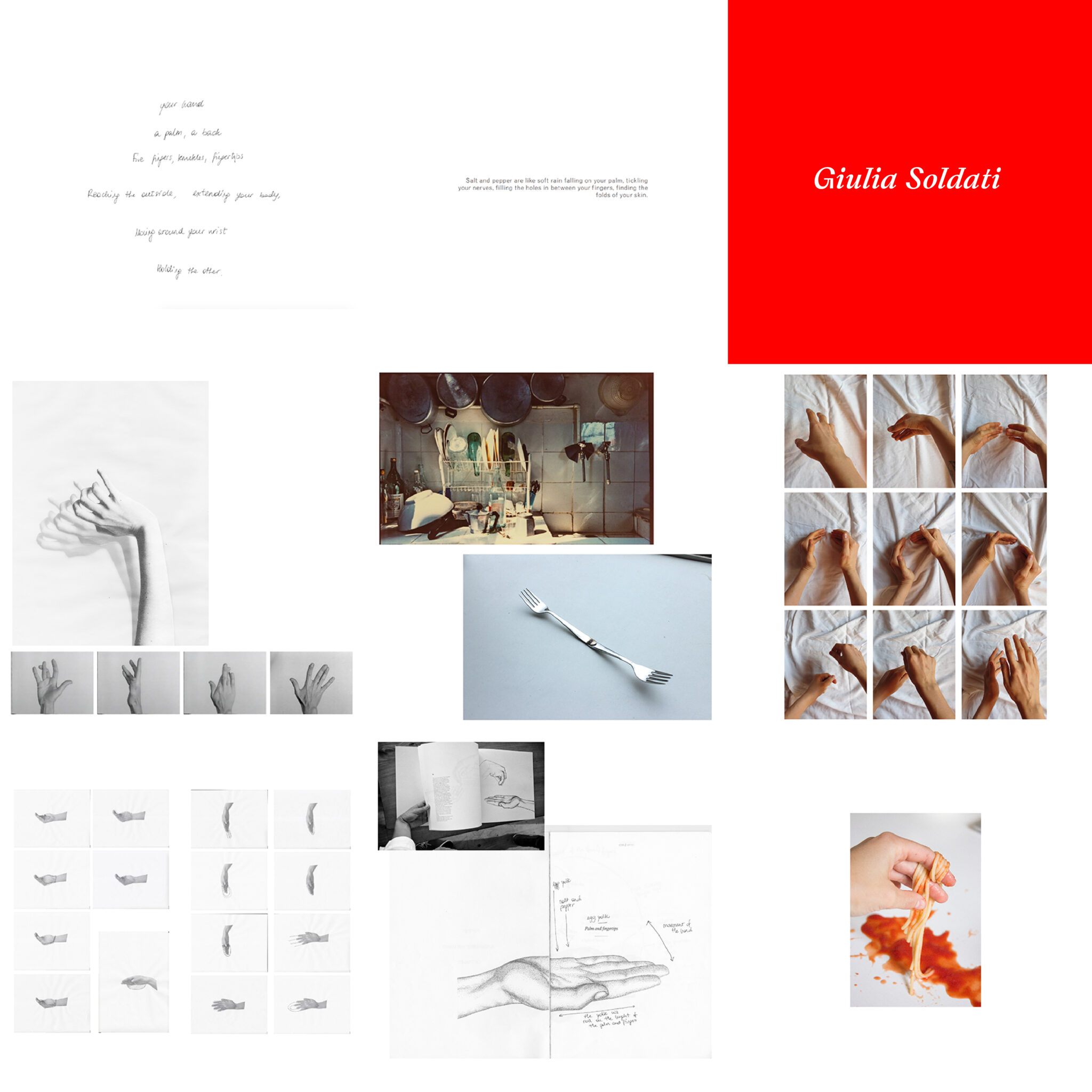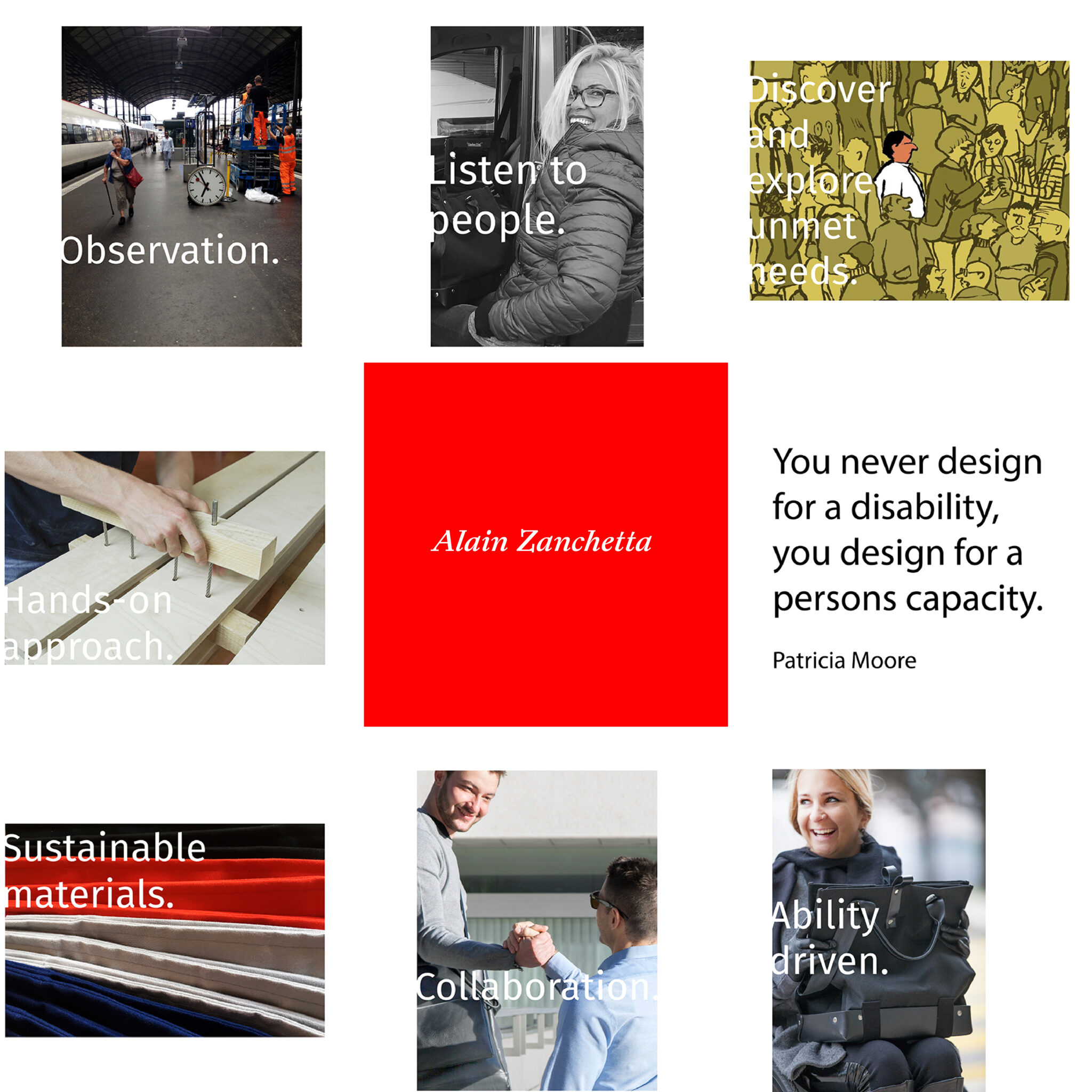
#PostIt
Online Project
Nèo· presenta #PostIt
Il progetto è costituito da una tavola bianca in cui ciascun membro di Nèo· illustra il proprio mondo di ispirazione. L’obiettivo è quello di raccontare in maniera nuova una parte personale del metodo di lavoro di ogni designer.
Giuseppe Arezzi,
Beatrice Bianchet,
Sara Bizzocchi,
Elisabetta Boi,
Alessio D’Ellena,
Andrea De Chirico,
Matteo Di Ciommo,
MAIS Project (Matteo Mariani e Isato Prugger),
Teo Sandigliano,
Giulia Soldati,
Alain Zanchetta
Il progetto è online e visibile sul canale Instagram di Nèo·,
https://www.instagram.com/neo_designitaliano/
Nèo· presents #PostIt
The project is a blank board which illustrates the world of suggestions of each member of Nèo· .
The aim of the project is to describe in a new way a small part of the personal method of working of each designer.
Giuseppe Arezzi,
Beatrice Bianchet,
Sara Bizzocchi,
Elisabetta Boi,
Alessio D’Ellena,
Andrea De Chirico,
Matteo Di Ciommo,
MAIS Project (Matteo Mariani e Isato Prugger),
Teo Sandigliano,
Giulia Soldati,
Alain Zanchetta
#PostIt is online, also on Nèo·’s Instagram,
https://www.instagram.com/neo_designitaliano/
Giuseppe Arezzi
“I like to observe how people use objects and spaces, reinventing their uses and adapting them to new contexts: a pan that becomes a shovel to collect waste, a wooden board suspended between two rocks and used as a sun bed. Anonymous objects and spaces having as main topic the theme of the vernacular – of all the projects without designers – where anthropological and sociological attentions become fundamentals.
This is my world of suggestions, curiosities and emotions: the pillars of my work as a designer.”
Notes:
1_Self-portrait with the “Armchair Manic”, Giuseppe Arezzi, Marina di Ragusa, 2017
2_Book “Libro D’Ombra”, Junichiro Tanizaki
3_Book “Super Normal”, Jasper Morrison and Naoto Fukasawa
4_Photo from my computer of the “Re-Fire Kit” project, Francesco Faccin, 2014
5_Photo from the book Loose Ends of the project “Concerto Nell’Uovo”, Maria Giuseppina Grasso Cannizzo
6_Photography of “Massamatassa”, Giuseppe Arezzi, August 2018
7_Photo of the poster “Objects are Enigmas” by Michele De Lucchi for Domus 1030, 2018
8_”Studio di Intrecci” and Testudo Hermanni, Giuseppe Arezzi, Ragusa, 2016
9_Two minimal iron benches, Giuseppe Arezzi, Donnalucata, 2016
10_Photo of the preparatory collages for the “Beata Solitudo” project, Giuseppe Arezzi, Milano, 2015
11_Scketches for “Beata Solitudo”, Giuseppe Arezzi, Milano, 2015
12_A man sunbathing on a wooden table suspended between two rocks, Giuseppe Arezzi, Ortigia, 2018
13_Photo of the installation “Beata Solitudo”, Giuseppe Arezzi, 2017
14_Watering Can and Broom , Giuseppe Arezzi, Ragusa, 2017
15_The chamber of a cloistered monk, Giuseppe Arezzi, Certosa di Pavia, 2017
16_Photo of the Museo Ettore Guatelli, Giuseppe Arezzi, Parma, 2018
17_ Paletta/Padella, an object found in a garden in Ragusa: my present to Achille Castiglioni for his 100th birthday exhibition at the Fondazione Achille Castiglioni, Giuseppe Arezzi; Ragusa, 2017
18_Folding chairs used as tables and scarecrows: my grandmothers method to dry Tomatoes, Giuseppe Arezzi, Ragusa, 2017
19_Mouse trap handcrafted by my grandfather, Ragusa, 2018
20_Kneeling on a step, transformed into a bench, Convento di Santa Maria Della Croce, Giuseppe Arezzi, Scicli, 2015
21_Photo of the Solista valet stand, Giuseppe Arezzi, Marina di Ragusa, 2018
22_Collar bottle for cans, Anonymous Design, Giuseppe Arezzi, Ragusa, 2018
23_ Anonymous objects from my grandfather’s basement, Ragusa, 2018
Beatrice Bianchet
“Beatrice grew up in a green little village, in Friuli’s taiga, surrounded by a church that looks like a factory to the south and mountains to the north. Color is her language, a language more universal than shape, and with this language she makes maps, interfaces, illustrations and gifs. Graphic designer, illustrator, behind her black round glasses, she is capable of taking care of the smallest details as well as the biggest projects, thanks to her super power of the overall vision. “
Notes:
1_Graphic design and illustration for cover book edited by UTET, Italy.
w/ XxY Studio
2_Icon made for new Stamp Brand Identity. Part of serie. w/ XxY Studio
3_Altreconomia magazine. Typesetting, photo selection, data visualization, icon design, cover design
4_Etna Calling, poster design. w/ XxY Studio
5_Etna Calling. Mix of languages, mix of colors
6_ My first illustration language. Illustrations made with torn paper. Inspired by Willem Sandberg
7_Texture for objects. New personal project
8_Texture for objects. Hands, spritz, friends, words
Sara Bizzocchi
“My research is based on the mutual relationship between human body and design. Especially, I am focusing on how this relationship can amplify its potential when interacting with science, biology and technology. I am fascinated by the vulnerability of the human body which promotes a natural tendency of adapting to changes. Regardless of the constraints, the body uses what is given to perform certain functions, even in the absence of structural parts. I think of the body as a territory without boundaries, without predefined limits.”
Notes:
1_Karen Elson in Skeleton dress by Iris Van Herpen, 2011. Credits: Luigi and Iango. From: irisvanherpen.com
2_Mex Siedentopf, How to Survive to A Deadly Global Virus, 2020. From: dezeen.com
3_Ewa Nowak, Incognito, 2019. Credits: Ewa Nowak. From dezeen.com
4_Ana Rajcevic, ANIMAL: The Other Side of Evolution, 2012. Credits: Ana Rajcevic, photo collaboration with Fernando Lessa. From: anarajcevic.com
5_Agamben Giorgio, Che cos’è il contemporaneo?, Nottetempo, 2008.
6_Lucy McRae, TransNatural #1, 2009. Credits: Lucy McRae. From: lucymcrae.net
7_Jennifer Crupi, Ornamental Hands. Credits: Christian Luis
8_Louise Bourgeois (1975) with the latex sculpture Avenza. Credits: Mark Setteducati. © The Easton Foundation / VEGAP, Madrid. From: guggenheim-bilbao.eus
9_Kyma Design, Y-Fork sketch. Credits: Elena Tonelli.
10_Rebecca Horn, Finger Gloves, 1972. Credits: Rebecca Horn Collection © 2019: Rebecca Horn/ProLitteris, Zurich.
11_Lucy McRae and Bart Hess, Evolution, 2008. Credits: Lucy McRae. From the guardian.com
12_The Alternative Limb Project, Phantom Limb. Credits: Omkaar Kotedia. From: thealternativelimbproject.com
13_Ana Rajevic, Amygdala MK2. Credits: Ana Rajevic. From anarajevic.com
14_Stelarc, Third Hand, 1980.
Elisabetta Boi
“How do we perceive space? What relationship do we have with objects? How do we react to the visual messages that catch our eyes? What are the responsibilities of the designer? These are some of the questions I ask myself every day. We are individuals, creative minds in constant ferment, with our actions, we generate reactions; as designers we have responsibilities. I am fascinated by the effects that time has on our projects, a time that always brings us back to satisfy primordial needs.”
Notes:
1_Typo Mask, Mamuthones mystery, Elisabetta Boi, 2014.
2_Boundary. Ronald Rael and Virginia San Fratello placed bright pink seesaws on the border wall at Juarez, Mexico and El Paso, Texas. The seesaws were fabricated in Juarez by a group of artists and the project was realized with help from Colectivo Chopeke, which focuses on bringing communities together through design.
3_Way of living. Ugo la Pietra ‘s interview extract.
4_Way of living. Image above: SanSimone village, it is populated only two days a year, it is one of the few remaining villages in Sardinia that has kept its ancient appearance, in fact, there are neither drinking water pipes nor electricity. To illuminate the night there are only torches which were only put on in 2001. In only two houses were solar panels for hot water and electricity. Sardinia, 2017, Elisabetta Boi.
5_London Parklet has the aim to make more sustainable, liveable, and attractive neighborhoods. The ultimate goal was to surpass the assumption that our streets are exclusively developed for vehicles. The project was created as a public space dedicated to pedestrians and cyclists, design concept Cyclehoop team, Anthony Lau, Elisabetta Boi, 2014
6_ Image below: Peanut the Turtle was found deformed by a plastic ring in the water: a plastic ring became lodged around the animal, and the turtle grew around the ring taking the shape of a peanut, unknown author, 2013.
Image above: Opensource redesigned cans that on the top and bottom have a semi-screw mechanism, that allow cans to be “locked together” and carried like a tube, FitPacks to avoid plastic rings, Corona, 2019
7_Image on the right: Vittoriano Viganò, terrace set, unique example for the Beltchev house in Portofino (1951). Italian Design Beyond the Crisis: Autarky, Austerity, Autonomy Triennale Design Museum of 2014-2015 an exhibition that reminded us that designing in the years of economic crisis is a particularly favorable condition for stimulating design creativity.The autarchic period, from the origins of design to the 1930s, then analyzes that historical period of the 1970s marked by the economic crisis.
Image on the left: Model for the visualization of the mechanism of a moving chair, fabricated on the occasion of a lawsuit Lorenz versus Berkline, 1963.
8_The role of design, both expert and nonexpert, in the ongoing wave of social innovation toward sustainability.
Design, When Everybody Designs: An Introduction to Design for Social Innovation, By Ezio Manzini, 2015
Alessio D’Ellena
“My aim is to investigate the *processes* of type design —and design itself— as a *non dogmatic* practice. Stressing the form, stretching the concepts up to corrupting rules and misuse of tools. I like to conceive typography as *system* and medium. Hypotexts, paratexts and thresholds are the fundamental dialectic loopholes, allowing research to killing any dogmatic attitudes or ex ante rules.”
Notes:
1_Digital Typography by Donald E. Knuth (Stanford, California: Center for the Study of Language and Information, 1999)
2_Etaoin Shrdlu by Frederic Brown, 1942 (ita in: Antologia Cosmolinea B-1)
3_Institutional Soup by Tim Hollander (http:// timhollander.com/institutional-soup/)
4_A not B by Uta Eisenrich, 2010 (Roma Publication) behingdesign
5_Jurassic Park by Michael Crichton, 1990 (Terza iterazione: «Ridisegnando la curva frattale i dettagli emergono più chiaramente.»)
6_ Leggere (read) by Bruno Munari (in Supplemento al dizionario italiano, Corraini Edizioni)
7_Scrivere (write) by Bruno Munari (in Supplemento al dizionario italiano, Corraini Edizioni)
8_DonaldDuck and the print in Mickey Mouse Booklet 1617 of 23 November 1986
9_ Black square on white background, Black circle, Black cross, by Kazimir Malevich, 1920-1923
10_Scrivere con la sinistra e’ disegnare (Writing with the left and’ draw) by Alighiero Boetti (from Insicuro Noncurante 1966-75)
11_Attempt to form squares instead of circles around a stone that falls into the water by Gino de Dominicis, 1969
Andrea De Chirico
“Why these 8 points
How to teach design? Is it really possible?
Which are the strategies and the techniques to do so?
How is the teaching practice affecting my design practice and viceversa?
I have been looking for answers to all these questions for years, and I do it partly through theoretical reflections, in books, and partly through my teaching practice. I do not hide my surprise when I realized that the pedagogical practice is the one that perhaps most of all influences my work and makes me constantly question it. Moreover, all my reflections on the current state of our reality almost always lead me to the theme of education. Pedagogy, as well as the places appointed to it, universities, academies and schools, must be the laboratories of reality and the places of transformation par excellence. Unfortunately, I often realize that this does not happen, above all because like all the other spheres of our life, this too falls within a neoliberal system that has a fatalistic ideology and an inflexible rejection of dreams and utopias, precisely the things we need the most I believe. The fact that I cannot find myself in the current academic system has given me the push to start looking for answers to my questions, and here I will share some of my findings. Even if presented in a fragmented and out of context way, the intent of these eight points is to start a collective debate around the theme of education, inside and outside our filtered bubbles.”
Notes:
1_Educazione e precarietà / Education and Precarity
Ben Hayoun on the University of the Underground – Design as Learning (A school of schools reader, Istanbul Foundation for Culture and Art) 2018. (…) If you wish to modify the way that institutions, politics and rules have been establish for the past hundred years, you must be ready to deal with fast-moving and ever-changing situations. It’s essential to understand how to endure precarity, as it’s an essential condition for social change”.
2_Educazione e la guerra / Education and War
Black Mountain College Bulletin – Liberal Education Today as a Tool of War (1943) (…) The preservation of our cultural heritages is not superfluous in a modern civilization; it is not a luxury…It is what we are fighting for. (…) A college must be concerned with scrutinizing the values of modern society and the frameworks through which people see themselves and their world; it must question convention and tradition, be unafraid to condemn or to criticize, be continually in search of the basic, the foundamental, the real. In time of war, when meaningless verbal symbols are multiplied a hundredfold, when emotionalism tends to replace analysis, when propaganda takes the place of information, and when unconsidered judgements make a thousand intermediate greys black or white, such education is of tremendous importance.
3_Educazione e Libertà / Education and Freedom
Pedagogy of the Oppressed, Paulo Freire, Verlag Herder (1968)
Knowledge emerges only through invention and re-invention, through the restless, impatient, continuing, hopeful inquiry human beings pursue in the world, with the world, and with each other. (…) Education as a practice of freedom denies that man is abstract, isolated, independent, and unattached to the world; it also denies that the world exists as a reality apart from people. Authentic reflection considers neither abstract man not the world without people, but people in their relations with the world. Education is constantly remade in the praxis, In order to be, it must become.
4_Un corso / A class
Practical Quotes, Fornasetti at Palazzo Altemps, Electa (2017)
To whom who are asking me how to learn “design”, this strange myth of our modern times, I answer: “go to a school of nudity, this is the place to learn design”.
5_Criteri di amissione / Admission Criteria
Education on a Mountain – The Story of Black Mountain College by Luis Adamic (…)
Among the desiderata are capacity for deep dejection and a tendency to say once in a while “I’m no good!”; a capacity for indignation and an inclination to get hot under the collar; a sense of order, a sense of form, and an inward love for truth.
6_Comunicazione / Communication
Note from the activity report from the “Communication” group of Global Tools (1974)
Carrying on our work we shall always remember that:
The men who make use of their experience, “exposing themselves to risks”, namely running the risk of losing their identities, slowly and progressively depriving themselves of every concern, feeling inclined to let others get in touch with them, and, in conclusion, to lose or to exchange with other people, something belonging to their own inner life, those men may be persons inclined to “communicate”. On the contrary, the person who has got a lot of experiences, who stores up information, and crams himself with notions, patronizing and fostering his self-assurance, maintaining his own unalterable identity and exploiting these experiences to increase his prestige in the group and in the society he lives in and acts on, we can assert that a person like that, really isn’t in the mood for communicating and actually exchanging his own experiences with other people’s.
7_Curiosità / Curiosity
Pedagogy of Autonomy, Paulo Freire, Edizioni GruppoAbele – (1996)
Being historical-socio-cultural beings, we, women and men, become beings for whom curiosity, overcoming the limits that are peculiar to it in the vital domain, becomes a fundamental factor in the production of knowledge. Even further, curiosity is already knowledge.
8_Una (possibile) Storia / A (suggested) Story
Global Tools (Casabella), tipologia didattica/didactic typology (Superstudio: Nota 1) (1973)
It may be that the history of the school began with a man sitting under a tree and teaching others. And surely a woman, while sheltering a child, began to teach him the names of things. So that the history of teaching is more a story of love than a story of teaching aids.
Matteo Di Ciommo
“Project process, search of beauty, God, idea, intention, design, research, attempt, aspiration, resolution or luck, accident, occasion, fatality, chance, lucky break.
The project is an intellectual necessity born in thought. It lives in a form and even more in its misunderstanding.
The concept of “thing” is its worst enemy, the object is its closest ally.”
Notes:
1_It would not make sense to design the ugly. Therefore, designing means aiming for the beauty. Succeeding in the scope is another matter.
2_Designing things is much more difficult than designing objects. Taking into account the actual possibility to do so.
3_The designer is a painter because the only thing that matters to him is the image. It’s hard to explain what exactly an image is. Well, I know it too.
4_There is an imagination that leads to the truth and one that leads to the mundane. The designer should have the first one.
5_Agamben Giorgio, Che cos’è il contemporaneo?, Nottetempo, 2008.
6_ “Thing” is a wonderful word; there is not an equally confused one that says even less.
7_An object can be designed in all and every thinkable ways. A “thing” almost cannot be designed. This makes everything way more complicated.
8_Think about clouds and ballast, yhey are wonderful and designed by the case. The same case that is God when he does not want to be noticed.
9_To design means finding the right path that leads the tragic to take possession of the trivial.
MAIS Project (Matteo Mariani, Isato Prugger)
“After a period of working with well known design studios and companies from Milan, Isato Prugger and Matteo Mariani merged their different but complementary experiences into one single design vision. In December 2019 they set up their work space in Monza. Driven by sustainable industrial production methods, they oversee the entire life cycle of their projects, taking into account the overall impact on society. They practice a structured scientific approach fed by entropy and creative serendipity.”
Notes:
ZERO – diverge
be a sponge, be permeable, be lazy,
ONE – capture
destroy, filter, understand,
TWO – interpret
synthetize, focus,
THREE – develop
make, talk, walk, meet,
phone, email, paper, laptop, car, hammer, glue, paint,
FOUR – fail
first time, second time, third time, fourth time, fifth time, sixth time, seventh time,
FIVE – promote
talk talk talk talk talk talk talk talk talk talk sell talk talk talk talk talk talk talk talk talk talk talk talk talk talk talk talk talk
Teo Sandigliano
“Design process…
I have always been interested in complexity, systems, connecting the dots. I like to understand how the world works. Exploration and research have always been fundamental because I’m curious. Design has become almost a tool: it always allows me to get to know new things and, depending on the project, to apply them.”
Notes:
1_Double page of my notebook (2016)
Perhaps my interest in complexity is also given by my complex and sometimes dark head. Just open a notebook, a notepad and you can find sentences in Italian / English / French, speeches, self-praise and curses. The pencil is the starting point…
2_Portrait with Pothos (2020) © T. Sandigliano
I tend to explore the world through a filter, a lens, the one of Nature. I believe in Nature and maybe we should all believe in Her a little more. Designers, but also entrepreneurs. Sometimes I think about the past and I wonder – what if we had built a civilization in sharing with nature?
3_Blu Villa, detail (2018) / Decorations, San Gregorio (2017) © T. Sandigliano
I learned the concept of beauty from Naure. I try to reproduce it, to follow it, to learn about it through every project. It fascinates me and it’s always one of my sources of inspiration.
4_Text taken from Discorso sulle Erbe, Fritjof Capra, Stefano Mancuso (2019) Aboca
Another important aspect for me is literature. It allowed me to better understand the world, the people and what’s around me. It gave me other points of view.
5_Bosco, Oropa (2015) © T. Sandigliano
So when I look at a forest I don’t think about trivial leaves and trees but, for example, about Stefano Mancuso’s words, about roots, about complex systems that I can’t see
6_Oil Massive Society (2016) / Oil Massive Society WIP (2016) personal work
And inevitably I find these systems in my projects and in my imagination. No longer related to Nature, but in different contexts, depending on the project.
7_Disarchitecture project (2014) personal work
My curiosity then pushes me further, to a change of perspective. I try to look at the world upside down, in a different way, to find the details that I have missed, to create something imaginative.
8_Brad Downey & Akay, Installation for Fame Festival (2011) © Frame Festival
The last aspect, perhaps the most important, is the game. The possibility of overturning rules, of building new worlds, and new panoramas starting from the simplest things.
Giulia Soldati
“Our body move in space and time, generating meanings and languages. What is a movement? Our body is a vocabulary of gestures, communicating with others.
Our hands are our personal tools.
A palm
A back
Five fingers
Reaching the outside.”
Notes:
1_Collage Hand movement, Giulia Soldati, 2016
2_ Images series from Yvonne Rainer, Hand Movie, 1966
3_Luigi Ghirri, Paesaggio Italiano
4_Giulia Soldati, 2013
5_Bread Gestures (From Gesture Series, Giulia Soldati)
6_Collage Hand Tools study, Giulia Soldati, 2015
7_Photo by Guido Van Nispen
8_Drawing by Giulia Soldati, 2016
9_Studio per Mangiamaccheroni, 2018
Alain Zanchetta
“I observe what happens around me; get excited about a topic; talk to people to exchange thoughts; then detect unmet needs, remembering that peoples abilities matters and that collaboration and participatory design will lead to products that join. I act responsibly by using sustainable materials; these will drive the form of the Object I am working on. Finally, by making a prototype I verify its function with users … This process is not linear, I redo it until we reach the goal.“
Notes:
1_“Observation” photo by Alain Zanchetta, 2019
2_ “Listen to people”, Alain Zanchetta, 2019
3_Discover” – Original artwork by Jean Jullien from Jean Jullien interview for Everpress. Link: https://everpress.com/blog/visibility-with-jean-jullien/
4_”Hand On Approach” Photo Credits: Alain Zanchetta, 2019.
5_”You never design for a disability, you design for a person s capacity”
Quote by Patricia Moore is an American Industrial Designer, gerontologist and author. Universal Design Pioneer
6_”Sustainable Materials” Photo Credits: Alain Zanchetta, 2019.
7_“Collaboration” – Photo Credits: Claudia Cossu, 2019.
8_“Ability Driven” – Photo Credits: Claudia Cossu, 2019.
Contacts
Web Design · Teo Sandigliano ~ Web Programming · Giorgio Martinetto ~ Laica Font · Design by Alessio D’Ellena, available and provided by Dinamo
